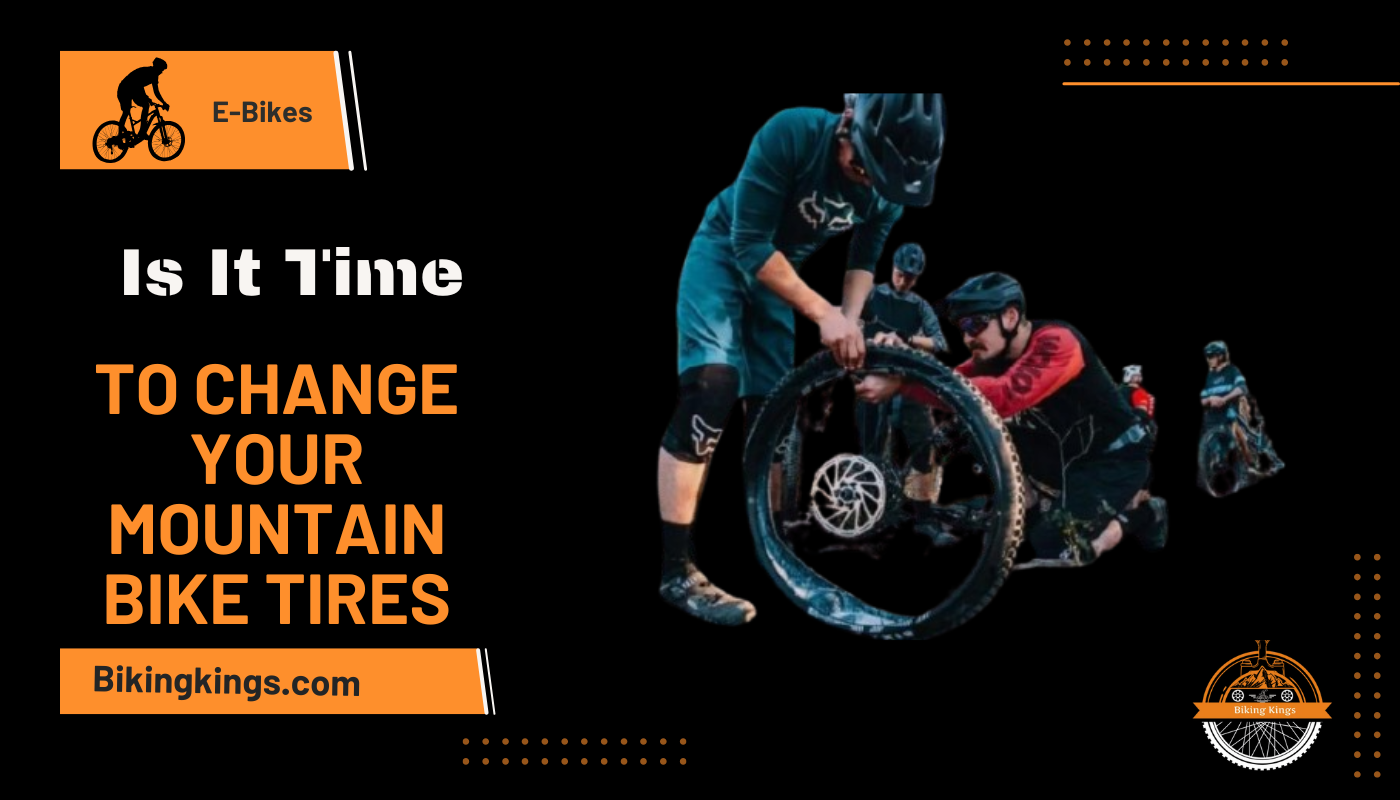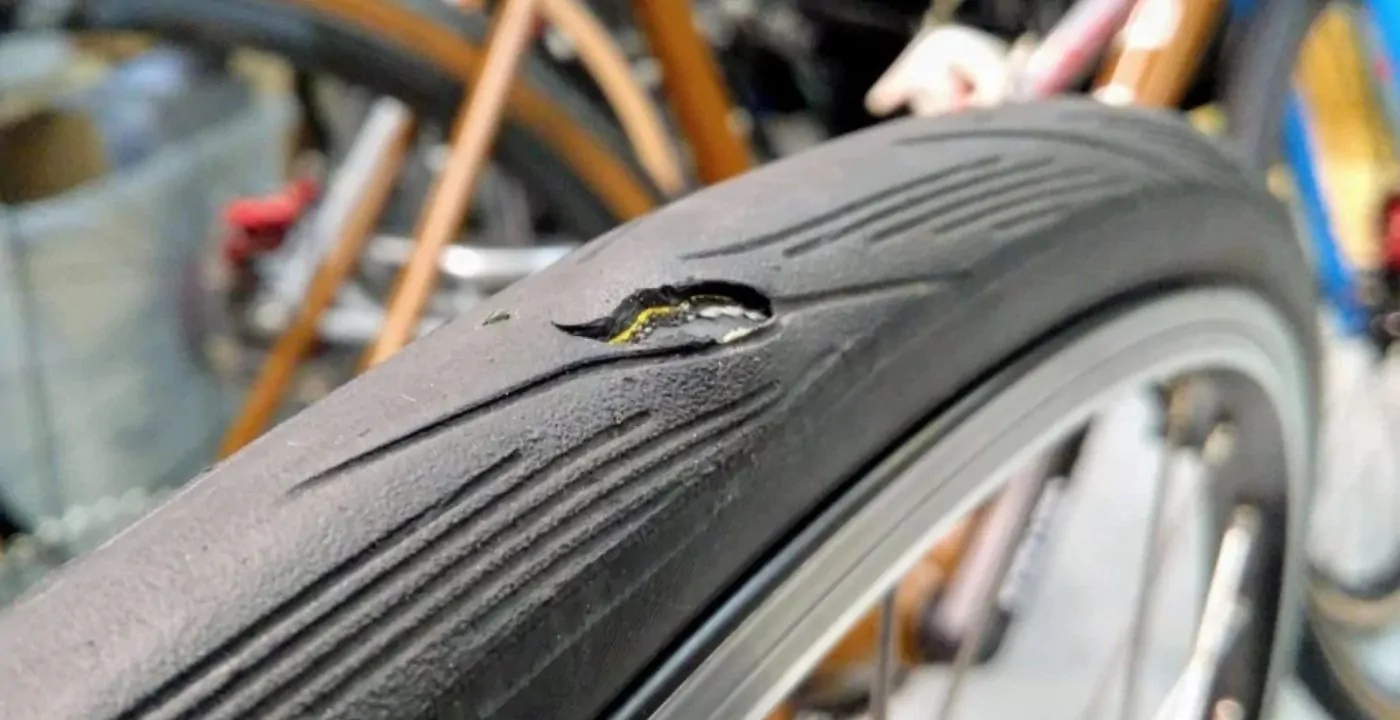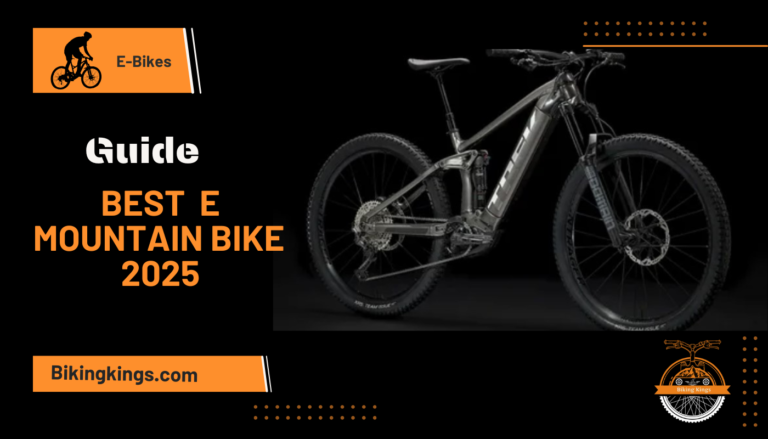The assurance of staying safe and ride on your MTB without a hitch depends on when you are supposed to change your tyres. This will place you in a situation where you risk several pitfalls if you fail to have the MTB tyres replaced at the right time. This is not what you would want to find yourself stuck in- frequent flats, losing grip, or worst, putting yourself at risk.
If you don’t have time, then the most important thing to remember is that you should replace mountain bike tyres when you notice holes, gaps, cracks in the tyre wall, blistering, worn knobs, or a lack of traction. You should also replace mountain bike tyres when they’ve lost 50% of their tread depth.
Knowing how long mountain bike tires last and how to change both your front and back tire on a mountain bike is something well worth reading up on in detail though. And with the aid of this guide you’ll be able to avoid some of the nightmares you may otherwise face if you don’t change your MTB tyres when they need it.
When to Replace Mountain Bike Tires
What to Watch Out for:
Holes and Gaps
This is a biggy. If you have holes showing through your MTB tyres or cuts down the side, then you have problems that need sorting pronto. Any cuts or gaps within the mountain bike tyres opens you to the possibility of sharp objects getting inside and, you know what that means – the dreaded flat mountain bike tyre.
Worn Knobs

If the knobs on your MTB tyres begin to wear away, plus the tyres themselves start looking flatter and smoother then you have problems. Loss of grip at the knob-worn areas means a chance of crashing, loss of power and other problems.
Traction
If your wheels are spinning and you are not getting any grip on the pavement or trail, then that’s an awful sign that your mountain bike tyres aren’t working as they should be. Unless you’re on a seriously muddy trail, your mountain bike tyres should hug the ground, and if they’re not then you know it’s high time to change your mountain bike tyres.
ℹ️ Be cautious with your assistance use on hazardous technical sections – the bike’s heavyweight, combined with its immense power, could lead to a nasty accident if you aren’t careful or don’t have the strength to cope with it.
Blisters

If, however, you have started noticing bulges on your mountain bike tyre that were not there when you bought them, this may mean that the MTB Tyre is at its end. Blisters and bumps on the tyre will manifest into further issues; a situation we could all avoid. So, there’s no need to remind you: it’s change time.
Cracks

If your mountain bike tyre starts looking like scorch earth, with cracks running down them, then you have problems. Your MTB tyres should look like one solid object; if there are worn cracks then you are, once again, opening yourself up to objects getting inside and raising the likelihood of punctures.
How Long Do Mountain Bike Tires Last?
Of course, this all depends on how much you ride your mountain bike; if it sits in the garage all year round, then the chances of you needing to replace your MTB tires are lesser as against someone who’s out ripping up the trails every single week.
But there are important indicators you can look at for a reference when you consider whether your mountain bike tyre is in good shape or ready to roll:
Tread

If your mountain bike tyre loses 50% of its tread depth and the knobs on your tyre have rounded edges, then you need to get those MTB tyres changed.
Mileage

The approximate distance mountain bike tyres usually last is around 3,000 to 8,000 miles. Now, of course, this is an awful lot of a range, but everything depends on where you ride your MTB, how you ride your MTB, in what sort of weather conditions you ride, and how you care for and store your MTB after use.
Why is it Important to Change Your Mountain Bike Tyres?
Security
If your mountain bike tyres don’t change at the right time, you may end up crashing. The moment worn mountain bike tyres become slack, it is easy for you to slide out as you take a corner curve sharp. It’s the last thing you would wish for yourself landing inside a ditch or in a hedgerow as you’re negotiating the trails.
Performance
You lose power if your MTB tyres aren’t gripping the ground properly. If your mountain bike tyres are badly worn, then you’ll find yourself exerting energy you really don’t need to. Simple rides become harder, therefore, and it will make keeping up with your pals that little bit more difficult.
Flats
Not very pleasent during a mountain bike ride is having to put up with flats. It will be a fight if the mountain bike tires are not changed at the right time, because that is not only time consuming, but also a cost; and can really destroy a good day’s ride.
How to Change a Mountain Bike Tyre?
Practice makes perfect with this, and it’s not a particularly speedy change to make at first, but hopefully, our step-by-step guide will make the process as painless as possible:
1. Take mountain bike tyre you are changing off bike by undoing the nuts then the levers on either side of affected wheel.
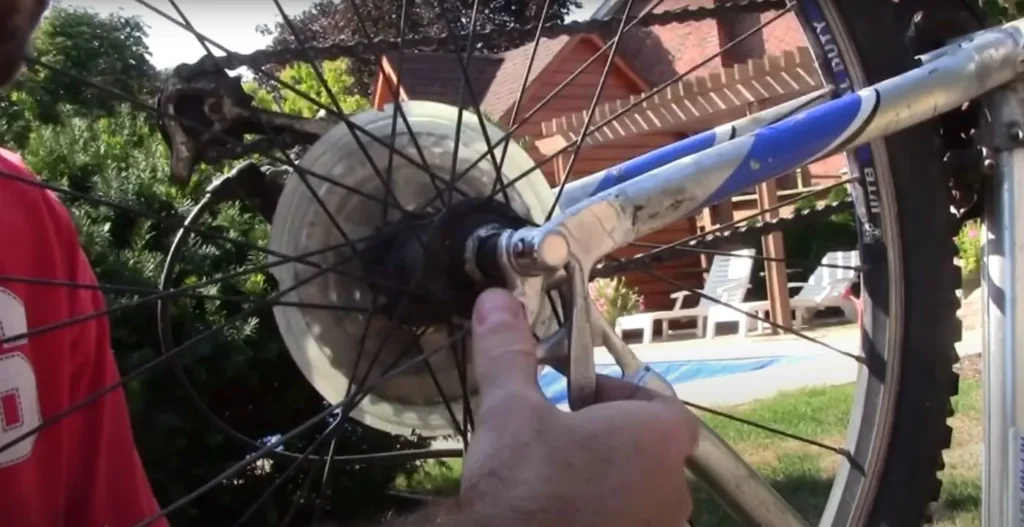
2. Once you have removed the bicycle, deflate the mountain bike tire using the valve .

3. Loosen the bead of the tire from the rim by squeezing with your fingers on one side of the rubber MTB tyre and then repeat the same process over the entire length of the tire.

4. You can now use your hand to get the MTB tyre off the rim but some are going to be trickier and you’ll have to exert some effort with the help of tyre levers to dislodge it off the rim.

5. Remove the inner tube by pulling it out of the rim with your hand. Once the tube is out you can now pry the MTB tyre off the rim as well.

6. All correct, next up is the new tyre. Place the new tyre over the MTB tyre rim, with hands use to put the tyre bead into one side of the rim.
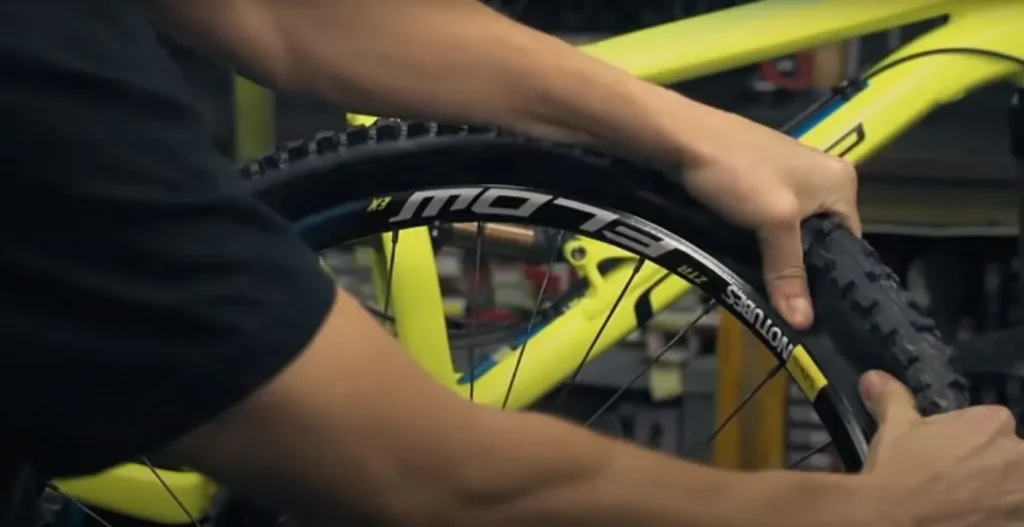
7. Once you’ve beaded the tyre back onto the rim on one side you can then put the inner tube back inside the new tyre and the rim.
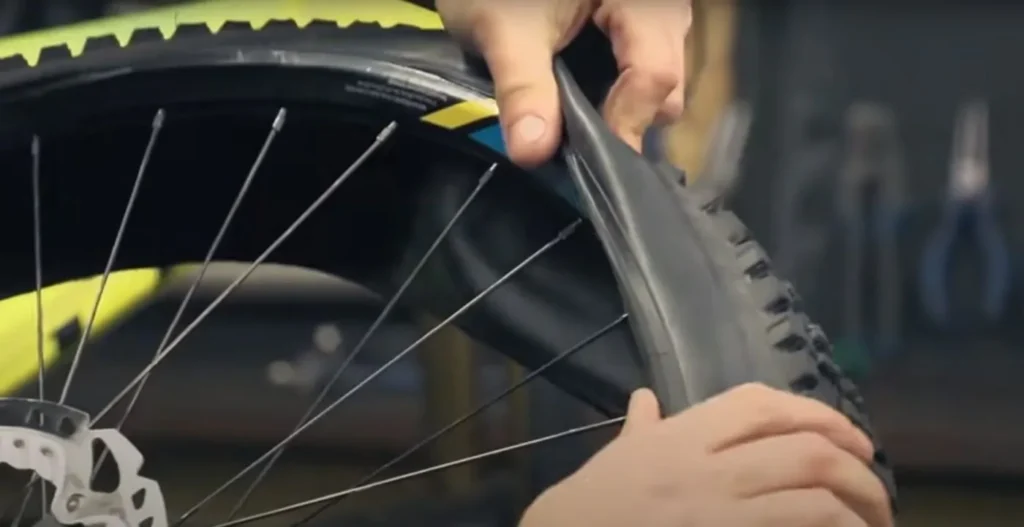
8. Once you have the inner tube back inside you can begin to push your hands through the gap between the tyre and rim to get the other side of the tyre back on the rim of your bike. Once most of it is on your will then have to use your tire levers to finish the job.
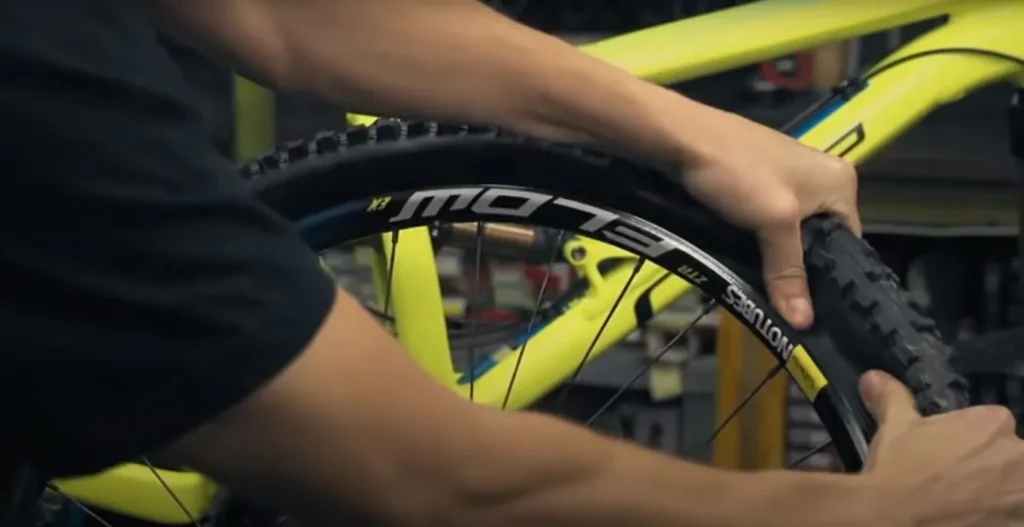
9. Once the tyre and inner tube are back on the rim you can now fit your tyre back to the bike reversing all that you did in Stage 1.

10. Now pump up the tyre using your pump and valve.
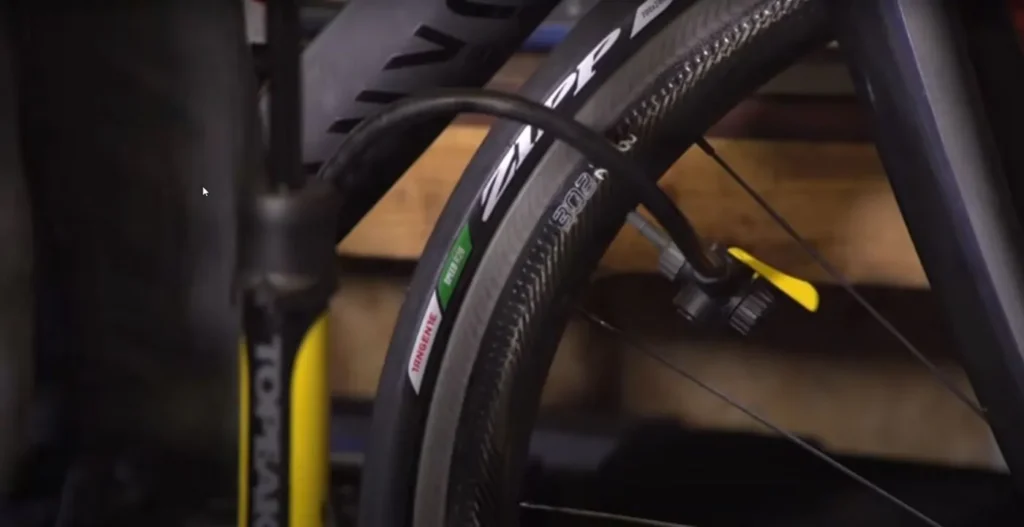
How to Change the Back Tyre On a Mountain Bike?
The process is very much the same as with the front tyre, but you now have the chain to consider.
1. Adjust your gears so that the chain will sit on the smallest ring. You don’t need to do this on the front tyre.
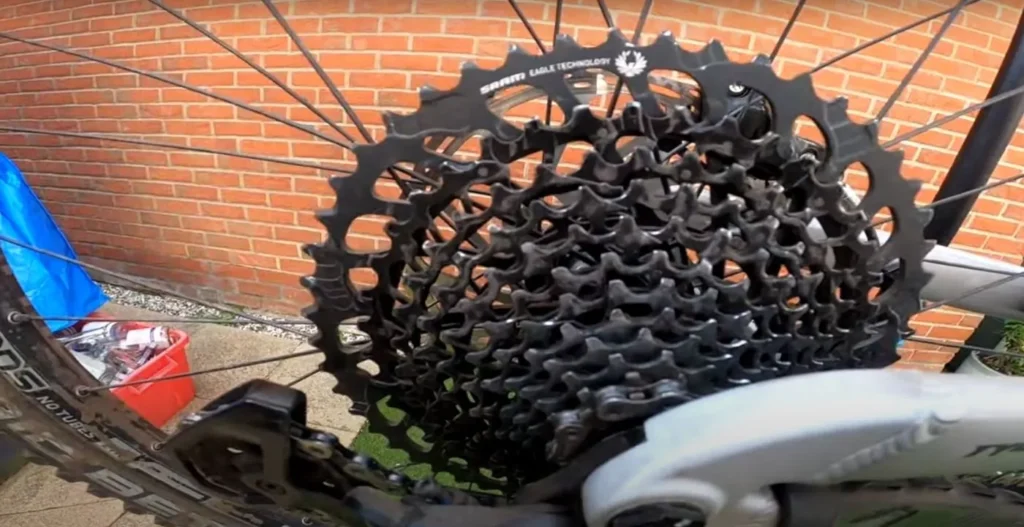
2. Upright the bicycle or affix it to a bike stand.
3. Position the nuts and levers on either side of the wheel and undo as you would for the front tyre.
4. For mountain bikes, loosening the nuts and levers normally releases the brakes, others will not free it and you will have to revert to using another lever over the brakes to free it.

5. Now pull the rear derailleur back and just a little bit, and the wheel should then come out smoothly from the chain and the derailleur.
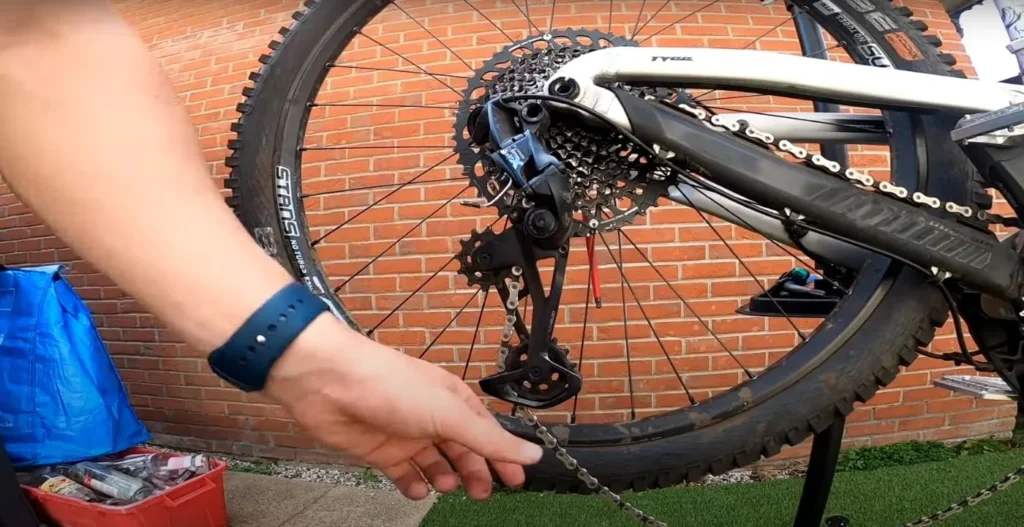
6. Removing the inner tube and tyre from the rim is exactly the same as the front tyre; (see our in-depth explainer above).
7. Replace your new back tyre and wheel onto your bike by doing the reverse of step 5. Put your wheel back in the chain, with it looping the underside and then plugging into the rear derailleur.

8. Reverse of step 3: tighten nuts and quick release levers.
9. Give the wheel a few spins to check that the seating of the wheel is proper and the chain catches correctly.
Job’s a good’un, you can now ride away into the sunset!
What are the Best Mountain Bike Tires for Beginners?
Chances are, if you are reading this feature, you’re just getting started on the mountain biking road. Before you throw out your old tires, you’ll want to decide on a new set that will suit your riding style and terrain. Here are a few critical numbers you should pay attention to before replacing your current tires:.
Two numbers you should make sure to write down when looking for new mountain bike tires are the measurements you’ll see on them. Mountain bike tires are measured by diameter x width. Example: 29×2.6″.
The number on the left measures out the diameter of your rim. You will really want to make sure to pay close attention to this number, as if you don’t, you may end up with the wrong tires. The number on the right is the width of the tire. There’s a bit of variation here, so you can run a fatter or skinnier tire as needed. If you want to run a wider tire in your frame, consider first what the maximum tire clearance is. If you can’t find a published width online, you might measure the distance between your seatstays and chainstays. Take that size, subtract a half-inch to make sure you have at least a quarter inch on both sides of the tire to allow for all the mud and debris. Best way is simply to keep the new tyre width to be identical to the size of your original tyre. Taking these statistics into consideration, here are four excellent mountain bike tires suitable for entry-level riders that will give you that sense of control and not hinder you when your skills increase.
As a side note, some mountain bikers tend to run two different tread patterns at the front and rear. For the purpose of making things simple, I’ve selected four of my favorite tires that can be used quite successfully as a front or rear tire. This makes tire purchasing a bit less of a hassle, since, on average, the rear tires tend to degrade faster than the front tires, so you can simply move the front tire to the rear and purchase a new tire for the front, thus on average requiring you to only replace one tire at a time. We rank these tires based on their “aggressiveness, that’s, how knobby they are, and the type of trail-and road conditions they are intended to handle. This ranking covers hybrid tires for mountain bikes, used as commuter bikes, fast-rolling cross-country tires, trail tires great all-around performers, and so forth.
Final Thoughts
It’s pretty crucial to change mountain bike tires so that your mountain bike is best performed. Otherwise you might have an unnecessary crash, regular punctures or just feel that the bike has a struggle.
You should be searching for any holes or gaps in the tyres, worn knobs, cracks, blisters, or any big change in traction/grip. Yet another good indicator is if your tread depth has dropped by 50%. The style of riding you’re doing and how much you ride will determine how quickly you will probably have to replace them.
Pavements and roads will generally wear out mountain bike tyres much more rapidly than a soft muddy path, similarly sharp edged edges on rocky trails will also cause more shock and more alteration of damage.
If you’d like to learn more about mountain bikes then why not have a read of some of our other blogs and guides??
Happy riding.

